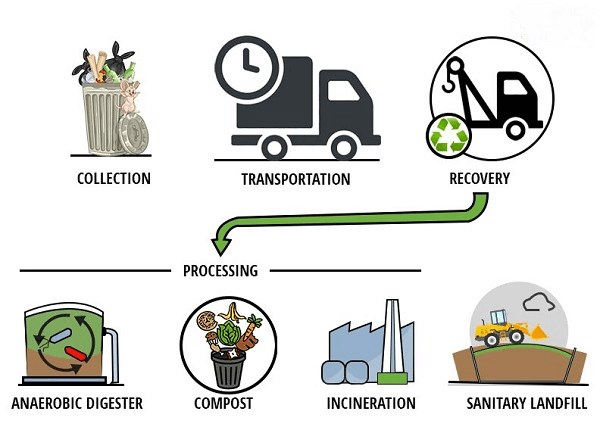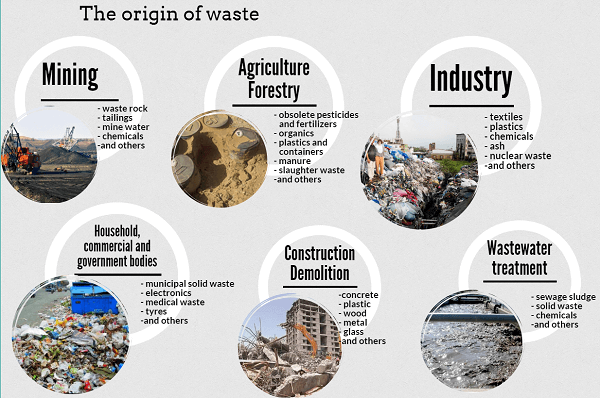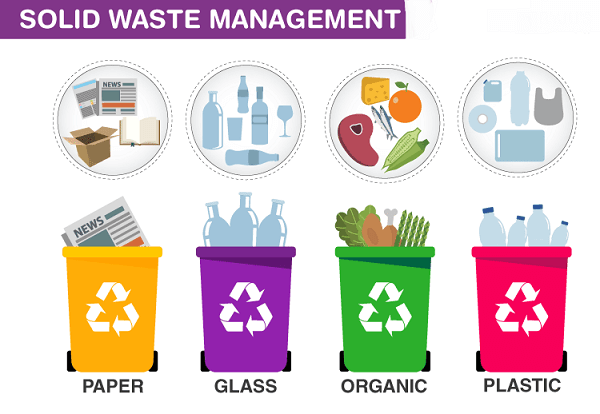Solid Waste Definition
Today, rubbish heaps are a regular sight. Thrown trash is everywhere in the form of decaying mounds that litter our environment, contaminate our rivers, and contaminate our wells & lakes. Trash has effectively crossed the urban-rural barrier, such that even the notion of a cute, tidy hamlet is no longer true. What is this garbage, why is it being generated and shown in greater quantities, and how have we become good at it? Most importantly, can society as a whole and as individuals lessen this rising threat?

Solid Waste
Solid refuse is defined as unwanted or futile solid items produced by individuals in homes, businesses, or industrial environments. It may be divided into three categories. It's according to
- Contents (organic material, metal, glass, plastic, paper, etc.),
- Origin (domestic, commercial, industrial construction, or institutional),
- Hazard potential (toxic, non-toxic, flammable, radioactive, infectious, etc.).
Through solid waste management, the detrimental effects on the environment & human health are reduced or eliminated. For a municipality, handling refuse proficiently entails a variety of methods. These involve maintaining track of, collecting, transferring, processing, recycling, and discarding. The main causes of the variation in waste production are different lifestyles, which are negatively connected with the socioeconomic status of the urban population.
Numbers!
Each individual produces 0.8 kilograms of trash each day on average in India's biggest cities. According to estimates, metropolitan India generated 0.573 million metric tonnes per day (MMT/d) or 68.8 million tonnes of municipal solid Waste (MSW) in 2008. The average collection efficiency for MSW ranges from 22% to 60%.
MSW typically contains 51% organic, 21% inert waste, 17% recyclables, and 11% hazardous waste. However, around 40% of all MSW is never found, and as a consequence, it pollutes surface water, leaves a city or town in disarray, and travels to nearby sewers. Open dumping caused by unsorted waste collection and transportation pollutes the environment and creates leachate and gaseous pollutants. Leachate pollutes adjacent surface water as well as groundwater, and gaseous emissions contribute to global warming.
Solid Waste Types
Based on the source, it may be divided into many types:
- Municipal Solid garbage (MSW): Produced mostly by residential and business complexes, it comprises home garbage, debris from construction and demolition (CnD), sanitary wastewater, and street rubbish. According to the MoEF, it comprises treated bio-medical waste created by businesses and households in municipal or notified regions in solid or semi-solid form, excluding industrial hazardous wastes;
- Solid industrial Waste (ISW) as they may contain poisonous materials, be caustic, very explosive, or react when subjected to specific things, such as gases, they are often classified as hazardous Waste.
- Biomedical waste or hospital trash is typically in the form of syringes, swabs, wraps, body fluids, feces from people, etc., that are disposable. Garbage that includes sharps, dirty items, disposables, anatomic Waste, abandoned drugs, chemical wastes, etc., may also be included in infectious trash. If not handled with care and science, they might pose a major risk to human health.
Management of Solid Waste
The centralized technique entails gathering municipal garbage from around the neighborhood and disposing it beyond the city/nagar panchayat boundaries through land filling. In this procedure, garbage pickers go door to door and collect solid Waste before giving it to the collecting crew, who dumps it in the landfill. Employees of the Municipal Corporation and Nagar Committee are the rubbish pickers. A bidding procedure is often used to hire the collecting crew.
Decentralized approach: This strategy is used in a few locations, including Bangalore in Karnataka and Suryapet in Andhra Pradesh. The trash is divided into biodegradable and non-biodegradable types at the source before being collected by the ward. The biodegradable trash is composted at a facility nearby using various aerobic and anaerobic composting techniques. Paper, plastic, metal, and other non-biodegradable garbage are further sorted, and recyclers gather them for up cycling or down cycling goods.
Treatment for Solid Wastes
- Thermal processing: Burning trash with oxygen produces carbon dioxide, water vapor, & ash. This process is known as incineration. It is a technique for recovering energy from garbage and is also known as the garbage to Energy (WtE) approach. Its advantages include decreased transportation costs, greenhouse gas emissions, and garbage volume. However, pollutants like mercury, lead, and dioxins may be discharged into the atmosphere and harm human health when waste is burnt.
- Pyrolysis & gasification: In these processes, the air is either completely absent of oxygen or present in very small amounts. Utilizing microorganisms to break down the waste's biodegradable components is known as biological treatment. The following two processes: Aerobic: This requires the presence of oxygen, which involves in-vessel composting, windrow composting, and aerated static pile composting. Absence of oxygen results in anaerobic digestion.
- Open dumping and Sanitary landfills: This is the regulated disposal of trash on land that minimizes interaction between the Waste & the environment and concentrates the Waste in a specific location. Leaving trash in the open exposes waste to the elements, wild animals, and birds. This results in the pollution of water as well as land resources due to a lack of monitoring and a leachate collecting system.
Solid Waste Management that is Integrated (ISWM):
Recycling
Recycling is the process of turning garbage into something beneficial. The amount of waste that must be managed, the cost of doing so, the detrimental effects of putting it in a landfill, and other factors are reduced. When referring to recycling, the terms "up cycling" and "down cycling" are often employed.
Up cycling refers to improving a commodity via various recycling procedures. Using inexpensive plastic to construct roads is one example of up cycling. Down cycling refers to degrading a product via various recycling procedures. The breakdown of high-quality polymers into several lower-quality plastics at high temperatures is an illustration of down cycling.
In India, a sizable number of people work as informal rubbish collectors. They are referred to as "Kabadiwallahs," or regional garbage traders. They gather and categorize dry trash, such as metal, plastic, paper, and glass. In the garbage market, each waste gets a set price. These local rubbish dealers sometimes collaborate with collectors who provide waste from the neighborhood. The dealers additionally collect dry garbage from households, flats, and establishments in addition to garbage pickers.

Accountability and Parties Involved
- Because solid waste management is a state-level concern, it is the responsibility of the state government to ensure that appropriate solid waste management techniques are adopted in every city and town within the state. However, SWM is a municipal duty, and the urban local bodies (ULB) are directly in charge of it.
- The SWM in each city or town must be planned, designed, operated, and maintained by the ULBs. The 4378 municipalities in India spend a lot of cash on trash management. SWM normally receives between 10% and 50% of the municipal budget and employs 30% to 50% of the workforce.
- The performance of this vital function leads to a decline in health, sanitization, and environmental quality. A ULB needs to provide adequate service because of a poor choice of technology, a lack of public involvement, budgetary restrictions, and institutional weaknesses. To manage solid Waste scientifically and economically, the ULBs need help and guidance.
- The government's general responsibility is to provide policy directives and, where appropriate, offer technical support to the states and cities. Additionally, it aids in developing human resources for municipal and state governments and serves as a conduit for securing outside funding for solid waste management programs.
- Numerous NGOs, garbage trade unions, and specialists have emerged as key players. Several well-known organizations and names include Hasiru Dala in Bangalore, India Solid Waste Management Round Table, Chintan in Delhi, Swacha in Pune, India, Stree Mukti Sangathan in Mumbai, and Chintan.
SWM-related Laws and Regulations
One of the 18 functional areas of the Municipal Corporations & Nagar Panchayats under the 74th Constitutional Amendment is managing and disposing of Municipal Solid Waste. The many guidelines for managing solid WasteWaste include the following:
- Rules for the Management and Handling of Biomedical Waste, 1998
- Rules for the Management and Handling of Municipal Solid Waste from 2000
- 2011 Rules for the Management and Handling of Plastic Waste
- 2011 Rules For The Management And Handling Of E-Waste
In terms of India's solid waste management, there are additional significant court cases:
- Almitra Patel vs. the Indian Union
- B.L. Wadhera vs. the Indian Union.
- Karnataka High Court's decision on source-mandated segregation
Manual Scavengers and Rag pickers
- Other unofficial participants in Waste Management include rag pickers. They work at local trash dumps and dumping grounds and exchange their waste collection with nearby traders.
- These neighborhood vendors are known as kabadiwallahs. Because the Kabadiwallahs are linked to the official community of recyclers who come & pick up the bulk amount of rubbish, the huge network of the informal sector also helps in the efficient management of waste at local levels. In India, there is a National Association of Rag picker.
- The National Solid Waste Association of India is what they go by. The organization established on January 25th, 1996, and is an associate of the International Solid Waste Organization (ISWA), offers a venue for sharing knowledge and experience in Solid Waste Management on a global scale.
- The Lok Sabha enacted the Prohibition of Occupation as Manual Scavengers & their Rehabilitation Bill, 2013, in September 2013. Manual scavengers and rag pickers

How Every One of us can Minimize Waste?
Waste is a duty shared by us. By adhering to the 4 Rs philosophy, we may implement a waste reduction plan within our homes or at work. This will transform garbage into a resource, conserve our rapidly decreasing natural resources, and decrease the quantity of trash going to landfills.
- Reduce: You may start by making purchases at home that come in less packing, are more dependable and refillable, are carried in your purchasing bag, don't use throwaway products, and use less plastic. In the workplace, one may reduce paperwork and communicate through email.
- Reuse: Donate your used clothing, books, phones, and various other items. You may purchase rechargeable products rather than recyclable ones and repurpose old bottles and jars as storage containers.
- Recycle: Separate your garbage for easier disposal, and buy recycled or environmentally friendly items. About 7,000 gallons of water, 17-31 trees, 60 kg of air pollutants, and 4,000 kWh of energy are saved by producing one tonne of recycled paper. Your organic waste may be immediately recycled or composted at the source, reducing the amount of garbage in landfills.
- Recovery or reclaiming: Various mechanical, biological, and caloric processes and technologies may reprocess or break down the trash into new components that can be used to create new materials and energy. This entails converting Waste into fuels for industrial techniques or machinery intended to generate energy. For instance, recycling the methane produced by decomposing materials in landfills is possible. Of course, this "R" is challenging for people to implement and is more relevant to businesses or communities that handle large amounts of rubbish.
Conclusion
SWM in India has to be improved. Public health, India's environment & Indians' quality of life are all at risk from improper SWM. Recovering resources from trash is necessary for better SWM in India. In addition to increasing value and improving projects' economic viability, it also increases their sustainability. Any attempt to keep MSW out of landfills, especially the filthy dumps in India, would aid the cause. India should choose one, many, or a mix of these options that will be advantageous to the nation.
|



 For Videos Join Our Youtube Channel: Join Now
For Videos Join Our Youtube Channel: Join Now










